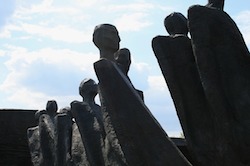by Holly Johnson
 The month of May in many locations heralds the return of spring and the renewed energy of insects, birds, and animals. They forage throughout their landscapes, spreading and scattering seeds, nuts, and pollen as they travel. With their movement, they create a natural diaspora that spreads life to new locations that may be appreciated or rejected, depending on how that new life is perceived by the environment in which it starts to grow. Similar to this natural diaspora and subsequent outcomes in the new environment, human diaspora also interjects lives and situations that are either appreciated or resented within the new environment with treatment similar in replication to that which is found in the natural world. Yet, all too often, human diaspora is not “natural” but rather forced as part of horrific circumstances generated by other human beings who do not recognize the humanity of those they have displaced, mistreated, or killed.
The month of May in many locations heralds the return of spring and the renewed energy of insects, birds, and animals. They forage throughout their landscapes, spreading and scattering seeds, nuts, and pollen as they travel. With their movement, they create a natural diaspora that spreads life to new locations that may be appreciated or rejected, depending on how that new life is perceived by the environment in which it starts to grow. Similar to this natural diaspora and subsequent outcomes in the new environment, human diaspora also interjects lives and situations that are either appreciated or resented within the new environment with treatment similar in replication to that which is found in the natural world. Yet, all too often, human diaspora is not “natural” but rather forced as part of horrific circumstances generated by other human beings who do not recognize the humanity of those they have displaced, mistreated, or killed.
 A general definition of diaspora is a scattered population with a common origin that has spread from a smaller geographic area to a larger one, including a movement from an original homeland. Typically we think of this concept in relation to historical situations such as the expulsion of Jews from Europe, the African Trans-Atlantic slave trade, and the importation of southern Chinese who were indentured or deceived into becoming very cheap labor during the development of the Trans-Continental railroad. More recent kinds of diaspora are defined by the causes of those movements, including imperialism, war, trade or labor migration, natural disaster, or by the type of diaspora community and its relationship to its original homeland. Included in the current understanding of diaspora is the internal diaspora that is part of a mobile population, such as that found within the USA. Some diaspora communities maintain strong political and economic connections to their homeland or home place.
A general definition of diaspora is a scattered population with a common origin that has spread from a smaller geographic area to a larger one, including a movement from an original homeland. Typically we think of this concept in relation to historical situations such as the expulsion of Jews from Europe, the African Trans-Atlantic slave trade, and the importation of southern Chinese who were indentured or deceived into becoming very cheap labor during the development of the Trans-Continental railroad. More recent kinds of diaspora are defined by the causes of those movements, including imperialism, war, trade or labor migration, natural disaster, or by the type of diaspora community and its relationship to its original homeland. Included in the current understanding of diaspora is the internal diaspora that is part of a mobile population, such as that found within the USA. Some diaspora communities maintain strong political and economic connections to their homeland or home place.
Qualities or themes of many communities or individuals encompassed by these movements include thoughts of return . . . affiliation with other communities in the diaspora . . . lack of full assimilation into the host country.
The books for this month address these themes, and will include discussion around picture books, poetry, novels, and informational books that allow all of us to enter the world of those affected by diaspora and the subsequent treatment they received as a member of communities displaced by a variety of circumstances. To start, you might want to review the 18 books I have highlighted here. I hope to tell you more about them and others in the next couple of weeks. Perhaps, by understanding the situation of those who are often forced to move, we will have a greater understanding of who they are, and by extension who we can be in connection with them.
Please visit wowlit.org to browse or search our growing database of books, to read one of our two on-line journals, or to learn more about our mission.
- Themes: Holly Johnson
- Descriptors: Books & Resources, WOW Currents



